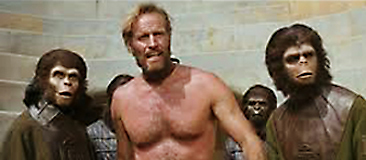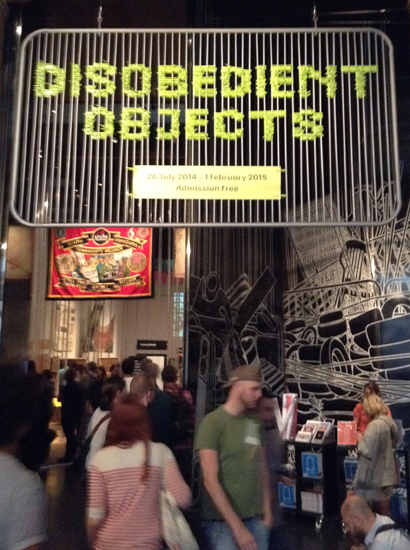What does it mean to be human?

Fig. 1 Planet of The Apes, film still (1968) [image online]
Available at: http://www.cinemasquid.com/screenshots/sets/planet-of-the-apes/87658604-a190-4d28-a903-2735b14d326f
[Accessed 27 October 2014]
I’m now considering how to reinforce the links between my Research and Enquiry work and the creative process in my Practice 1 project. In time, I hope to explore the ways in which “Socially and Politically Aware Graphic Art” might express concepts of “Humanity”, which is now set to be my FAT1 keyword. But initially, I feel that I should have some deeper understanding of the term “Humanity” might represent in an academic context.
Thus, the first search I’ve made (within the UH online library) in connection with this matter is “what does it mean to be human?”, which results in a number of texts being identified with the very same title. An article by Philippe Rochat, from the Journal of Anthropological Psychology (2006), commences with the assertion that while “we share 98% of our genetic make-up with chimpanzees, we evolved unmatched ways to relate and deal with each other” (Rochat 2006: 48). Reading on, it becomes clear that this is foremost a deliberation on the intricacies of human evolution, but that Rochat has a keen interest in the ostensibly intangible qualities of the human condition: “To capture what it means to be human, I would suggest that one must focus not on what is inside the individual but rather on the way human individuals transact and share resources among themselves” (Rochat 2006: 48).
I am certainly drawn to the concept he presents of “the human niche” (Rochat 2006: 48) that we’ve carved out for ourselves in this world, always needing to adapt to a fast-changing environment in which we are the primary agents of the change: there may well be opportunities to convey such a ‘self-fulfilling prophecy’ visually…
…Also, in terms of linking with Socially and Politically Aware Graphic Art, it is interesting to note the extent to which Rochat thinks that humans are defined by “prestige” (Rochat 2006: 49), “reputation” (Rochat 2006: 49) and “property” (Rochat 2006: 50).
Approaching the same matter from a very different starting point, Pru Hobson-West’s article, Beasts and Boundaries: an Introduction to Animals in Sociology, Science and Society examines how human identity might be defined relative to animals, and the way in which our species treats animals. Hobson-West, referencing Descartes’ notion of beasts as machines, considers what justification there might be for an innate sense of superiority within humanity that leads [most of] us to assume we are dominant over other species and have the right to use them for our advantage: “Modernity relied on a positive view of humanity with animals seen as a legitimate resource to aid human progress” (Hobson-West 2007: 26).
Having discussed how mankind’s relationship with animals has changed over the centuries, particularly relative to our transition from an agrarian to industrial lifestyle, Hobson-West states that, due to ongoing technological developments, and experiments on animals over the past 150 years, it continues to evolve in ways that challenge our sense of self and concept of what humanity should be. In conclusion, taking the scallop to represent lower animal consciousness, Hobson-West asks “What is the meaning of aliveness and what distinguishes human aliveness from scallop aliveness?” (Hobson-West 2007: 36), but offers no answer.
In noting this reference to aliveness, and recognising an existentialist aspect to it, I sought out a text by Sartre that summarises his thoughts about humanity, finding an essay titled Existentialism is a Humanism. Herein he defends his philosophy while making its central tenets plain: “There is no human nature, because there is no God to have a conception of it. Man simply is. Not that he is simply what he conceives himself to be, but he is what he wills, and as he conceives himself after already existing – as he wills to be after that leap towards existence. Man is nothing but that which he makes of himself. That is the first principle of existentialism” (Sartre 1945: 3). It is both a discomforting yet potentially empowering view.
Further contemplating a darker side to mankind, M. Cherif Bassiouni states that the term ‘Crimes against Humanity’ was first employed in Article 6(c) of the London Charter at the Nuremberg Trials, though neither a formal definition nor convention for its use has ever been widely agreed. Relative to this Bassiouni professes that “the laws and writings of scholars throughout Western, Judeo-Christian, Islamic, and other civilizations have expressed the values and beliefs that life, liberty, physical integrity and personal dignity are among the fundamental rights of humanity” (Bassiouni 1993: 488).
According to the Collins Concise Dictionary, humanity is defined as follows: “humanity (hju:’maeniti) n., pl. -ties. 1. the human race. 2. the quality of being human. 3. kindness or mercy. 4. (pl., usually preceded by the) the study of literature, philosophy, and the arts, esp. study of ancient Greece and Rome” (humanity, 1995).
References
[Accessed 17 November 2014]
Hobson-West, P. (2005) ‘Beasts and boundaries: an introduction to animals in sociology’, Qualitative Sociology [online] 3(1) April 2007, pp.23-41. Available at: https://uhvpn.herts.ac.uk/,DanaInfo=scholar.google.com+scholar?q=pru+hobson-west+beasts+and+boundaries&btnG=&hl=en&as_sdt=0%2C5
[Accessed 27 October 2014]
humanity. (1995). In: Collins Concise Dictionary, 3rd ed. Glasgow: Harper Collins, p.630.
Rochat, P. (2006) ‘What does it mean to be human’, Anthropological Psychology [online] 17, pp.48-51. Available at: https://uhvpn.herts.ac.uk/,DanaInfo=scholar.google.com+scholar?q=what+does+it+mean+to+be+human&btnG=&hl=en&as_sdt=0%2C5
[Accessed 27 October 2014]
Sartre, J.P. (1945), ‘Exististentialism is a humanism’, University of Warwick [online], pp.1-14. Available at https://www.google.co.uk/?gfe_rd=cr&ei=nIyLVIXGCIaA0AXhgYHQCw#q=sartre-eih.pdf
[Accessed 13 December 2013]















